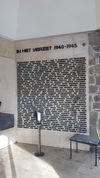

|
|
|
|
|
|
right wall, row 34 #02

Limburg 1940-1945,
Main Menu
The fallen resistance people in Limburg
Wilhelmus Hubertus Voesten (Willem)
∗ 26-03-1904 Venray † 18-10-1944 Tegelen (40)
- Unorganized resistance - People in hiding - Venray -

- Dr. F. Cammaert, Het Verborgen Front – Geschiedenis van de georganiseerde illegaliteit in de provincie Limburg tijdens de Tweede Wereldoorlog. Doctorale scriptie 1994, Groningen
 6. De Landelijke Organisatie voor hulp aan onderduikers, p.714
6. De Landelijke Organisatie voor hulp aan onderduikers, p.714 - Oorlogsmonument, Venray
- Archief Oorlogsgravenstichting (@ Nationaal archief),
Dossier Wilhelmus Hubertus Voesten #10 - Erelijst 1940-1945
- Nationaal Ereveld Loenen
oorlogsgravenstichting.nl • 4en5mei.nl, oorlogsmonumenten
Wikipedia • Nederlands • Deutsch - Oorlogsgravenstichting.nl
There are two versions about the death of 40-year-old farmer Willem Voesten on liberation day of Venray. According to both versions, he was shot because of his refusal, to work for the Germans. The first version is by Cammaert:
On October 18, German soldiers executed W.H. Voesten who refused to dig defenses. [1]
The second is from the book Veulen in WO II (Veulen in WWII) and was posted on the OGS website by ewaldssjeng:
He refused to go with the Germans to work in Germany on October 17, 1944, and was then shot by the Germans. Five boys from Heide brought him under heavy shellfire to the Red Cross post in Leunen. Later he was taken to the hospital in Tegelen. There he died October 18, 1944 at 3:30 p.m. He lived in Heide (village in the municipality of Venray) and was married to Maria Gielen in 1938. His name is listed on the War Memorial in Venray [2] which stands next to the Great Church. [6]
For Cammaert’s version speaks, that the farmers were indispensable for the food supply and therefore had a so-called agricultural exemption, which exempted them from forced labor in Germany, but not from building defense works. During that final period of the occupation, all men were either deported to Germany or in hiding or indispensable.
See also the story about Lambert Brands, the head of the food office in Valkenburg, who also issued agricultural exemptions to people in hiding.
Venray was liberated on October 18, 1944 during the battle of Overloon. The neighboring villages: Oostrum on November 23, 1944 and Blitterswijck on November 25. From this we can see how hard the fighting was there.
This is one of many stories about war crimes committed by the Wehrmacht, the regular German army. It shows once more that it really wasn’t just the SS that behaved like monsters in the occupied territories. Ulrich Matthaeas’ paratrooper battalion was also important in this context.
Reburied on the National Field of Honor in Loenen, grave D337 [3][5]
This person is listed in the “Erelijst 1940-1945” (Honor Roll of the Dutch Parliament). [4]
Footnotes